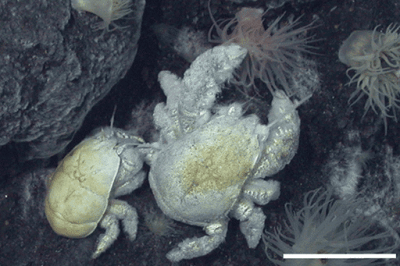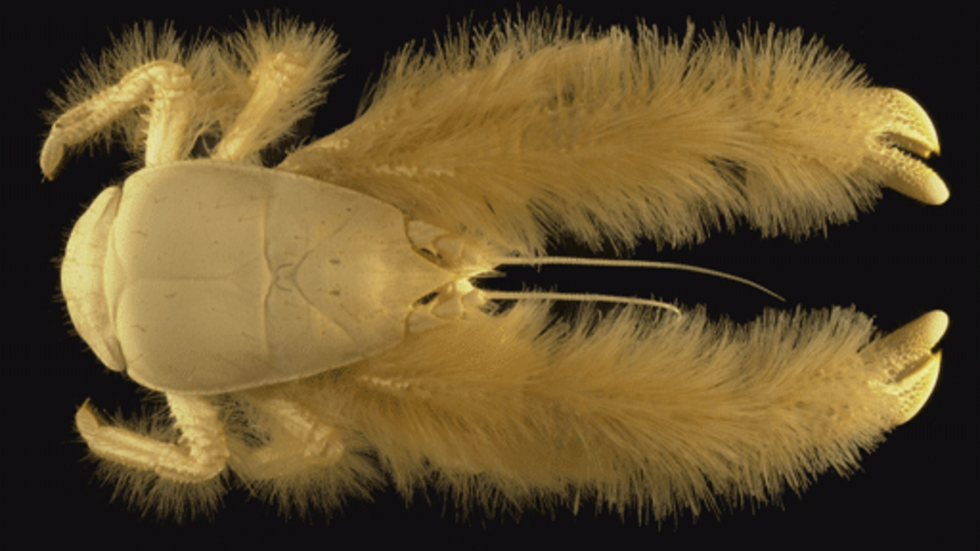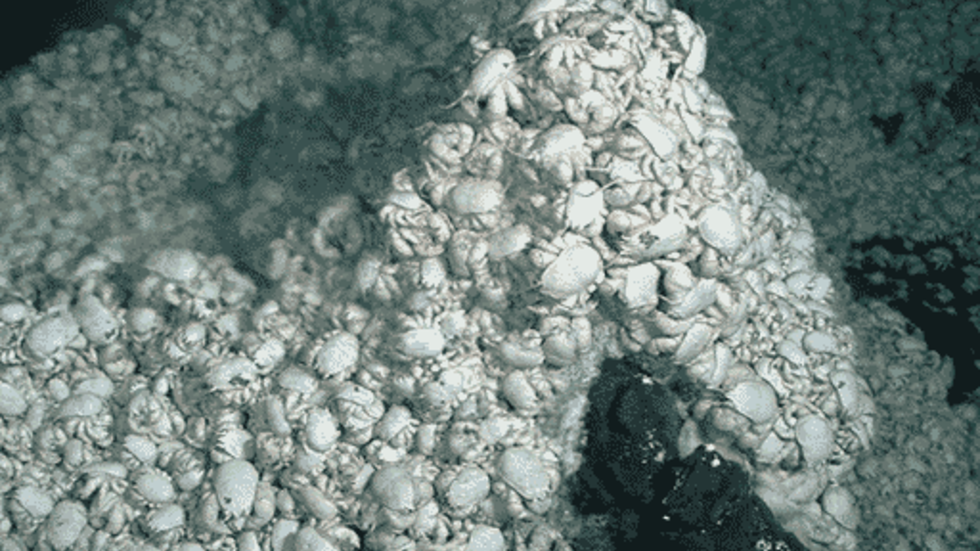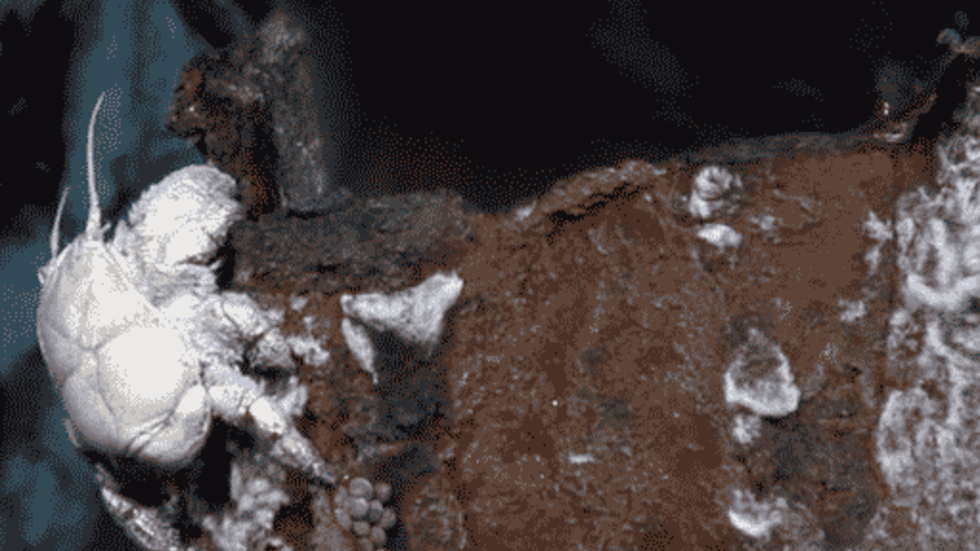Yeti Crab
Introduction
Depths away from the furry legend of the Himalayas, the Yeti crab is a crustacean that dwells in deep-sea hydrothermal vents, at depths of thousands of feet. Hydrothermal vents form when hot larva rises up beneath the seafloor causing Earth’s crust to split apart. The fluids carry minerals that are rich in sulfur and other metals that bacteria can synthesize to support a unique ecosystem of deep-sea animals.
Generally, large crustaceans like crabs and lobsters cannot survive in cold ocean regions, such as the waters surrounding Antarctica. As hydrothermal vents warm the water surrounding water with geothermal heat, they provide a habitat for the Yeti crabs in their immediate environment. There can be as many as 700 Yeti crabs in a square meter in a hydrothermal vent, so they are extremely successful and well adapted to these warm water “oases.”
The Name
 Kiwa tyleri female (left) and male (right). Credit: Thatje et al. PLoS ONE. CC BY | A Yeti is a fabled creature with wild white fur, and these crustaceans have a striking white, fuzzy-looking external morphology, which resembles their beastly namesake. As they are crabs, this texture is certainly not fur, but instead bristles called "setae," which cover their "chelipeds" (claws). Yeti crabs are, of course, much smaller than a Yeti, growing to only about 15 cm/5.9 inches long. To add to this crab’s sensational namesake, the genus name Kiwa comes from Polynesian mythology. Kiwa alludes to a goddess of shellfish in Polynesian culture.
|
Three Yeti crab species have been documented. Kiwa hirsuta was the first species to be discovered and is found in the Pacific-Antarctic Ridge. The species name hirsuta is the Latin word for “hairy.” The morphologically similar Kiwa tyleri lives in the coldest waters of any Yeti crab species, in the Southern Ocean. Scientists nicknamed it the “Hoff” crab because the bristles reminded them of the hairy-chested Baywatch actor, David Hasselhoff. The third species, Kiwa puravida, has only been found living near a vent off the coast of Costa Rica and is named for the Costa Rican saying “pura vida” that means “pure life.”
It is thought that the divergence between different species of Yeti crabs occurred around the Miocene (23–25 million years ago), when the Drake Passage opened between Cape Horn and the Arctic Peninsula, lowering the Southern Ocean’s temperatures.
A Crab? With Fur?
 Kiwa hirsuta. Credit: Census of Marine Life. CC BY-NC | The function of the "furry" setae is still debated. The chelipeds are covered in chemoautotrophic bacteria, which break down chemical compounds in the vent for energy to synthesize food, much like photosynthetic plants do with sunlight. Some scientists hypothesize that the crabs eat this bacteria. yeti crabs have been observed "waving" their chelipeds, which produce currents that help the bacteria make more food. This would mean that yeti crabs are essentially “farming” their food in a symbiotic relationship with these bacteria. Yeti crabs have also been observed eating mussels and the setae could also be used as a sensory mechanism to help them find food or mates. Did you know? Because hydrothermal vents are so dark, yeti crabs have no need for sight. They are completely blind! |
Discovering a Yeti
 Alvin submersible. Credit: NOAA. Public Domain | Remarkably, thermal vents had been the subject of scientific research for about 30 years before Yeti crabs were discovered. In 2005, a group of marine biologists led by Robert Vrijenhoek, first observed Yeti crabs in the Southern Ocean using a deep-sea submersible named Alvin that is owned by the United States navy and operated by the Woods Hole Oceanographic Institution in Massachusetts. The research vessel carrying Alvin was exploring the ridge near the Easter Island tectonic microplate. At 2,195 m/7,200 feet, Vrijenhoek and his team observed Yeti crabs squeezed between the crevices of rocks. One of the questions they hoped to answer, and it remains a mystery today, is how animals that live in deep sea hydrothermal vents can migrate from one hydrothermal vent to another, across vast oceans of icy water. Did you know? Artists have been an integral part of scientific expeditions since the eighteenth century; Captain James Cook is often credited. Previously images were drawn from participants’ oral and written accounts, but drawing and painting from life provided far more accurate information. The artist’s role is to help interpret new discoveries and present the research to a broader public. This tradition continues today. Lily Simonson has been the expedition artist on voyages around the polar seas and has made several paintings of the Yeti crab. |
Learn More
Browse
Encyclopedia of Life Yeti Crab web page
Learn more about Alvin, a deep-ocean submersible vehicle used for research
Read
A summary of the Yeti crab discovery from the Woods Hole Oceanographic Institute
Slideshow Image Credits
Kiwa hirsuta by A. Fifis/Ifremer, CC BY-NC; Yeti Crab assemblage by Thatje et al, PLoS ONE 10(6). CC BY; Male Kiwa tyleri,Thatje et al. CC BY




